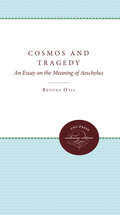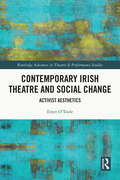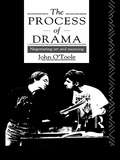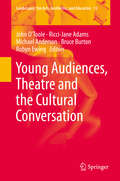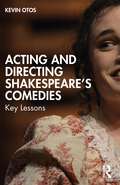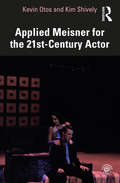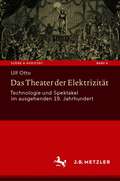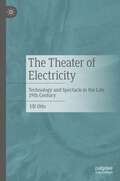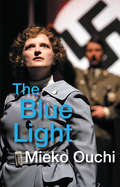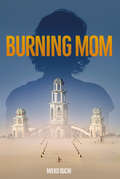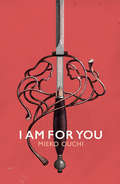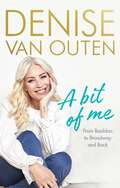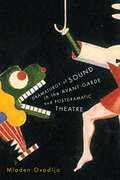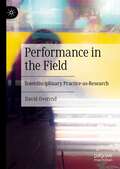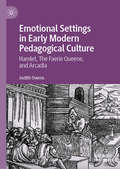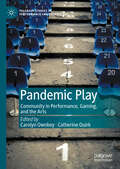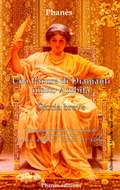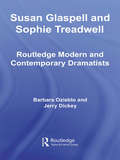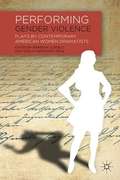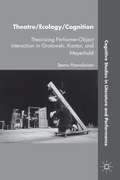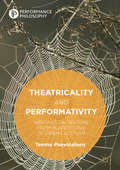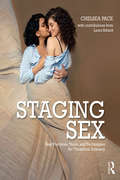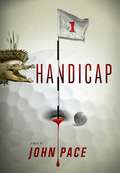- Table View
- List View
Cosmos and Tragedy: An Essay on the Meaning of Aeschylus
by Brooks OtisOtis clarifies the moral and theological issues raised in the Ortesia and relates them to certain stylistic and structural qualities of the three plays. He tackles the central questions of guilt, retribution, and the relation between human and divine justice, and he sees a carefully prepared evolution in the trilogy from a primitive to a more civilized form of justice. Otis treats the trilogy as a poem, a play, and a work of theological and philosophical reflection.Originally published in 1981.A UNC Press Enduring Edition -- UNC Press Enduring Editions use the latest in digital technology to make available again books from our distinguished backlist that were previously out of print. These editions are published unaltered from the original, and are presented in affordable paperback formats, bringing readers both historical and cultural value.
Contemporary Irish Theatre and Social Change: Activist Aesthetics (Routledge Advances in Theatre & Performance Studies)
by Emer O'TooleThis book uses the social transformation that has taken place in Ireland from the decriminalisation of homosexuality in 1993 to the repeal of the 8th amendment in 2018 as backdrop to examine relationships between activism and contemporary Irish theatre and performance. It studies art explicitly intended to create social and political change for marginalised constituencies. It asks what happens to theatre aesthetics when artists’ aims are political and argues that activist commitments can create new modes of beauty, meaning, and affect. Categories of race, class, sexuality, and gender frame chapters, provide social context, and identify activist artists’ social targets. This book provides in depth analysis of: Arambe – Ireland’s first African theatre company; THEATREclub – an experimental collective with issues of class at its heart; The International Dublin Gay Theatre Festival; and feminist artists working to Repeal the 8th amendment. It highlights the aesthetic strategies that emerge when artists set their sights on justice. Aesthetic debates, both historical and contemporary, are laid out from first principles, inviting readers to situate themselves – whether as artists, activists, or scholars – in the delicious tension between art and life. This book will be a vital guide to students and scholars interested in theatre and performance studies, gender studies, Irish history, and activism.
The Process of Drama: Negotiating Art and Meaning
by John O'TooleThe Process of Drama provides an original and invaluable model of the elements of drama in context, and defines how these are negotiated to produce dramatic art. John O'Toole takes the reader through a lively, fascinating account of the relationships between the playwright, the elements of dramatic art, and the other artists involved in this most interactive of creative processes. In doing so he demonstrates - with clarity and wit - how dramatic meaning emerges; how the dramatic event is constructed. Areas covered include: roles and relationships the drama space language and movement tension and the audience gesture and movement This is an essential book for every student of drama who wants to understand how the theatrical art form operates
Young Audiences, Theatre and the Cultural Conversation
by John O'Toole Ricci-Jane Adams Michael Anderson Bruce Burton Robyn EwingThis volume offers rare insights into the connection between young audiences and the performing arts. Based on studies of adolescent and post-adolescent audiences, ages 14 to 25, the book examines to what extent they are part of our society's cultural conversation. It studies how these young people read and understand theatrical performance. It looks at what the educational components in their theatre literacy are, and what they make of the whole social event of theatre. It studies their views on the relationship between what they themselves decide and what others decide for them. The book uses qualitative and quantitative data collected in a six-year study carried out in the three largest Australian States, thirteen major performing arts companies, including the Sydney Opera House, three state theatre companies and three funding organisations. The book's perspectives are derived from world-wide literature and company practices and its significance and ramifications are international. The book is written to be engaging and accessible to theatre professionals and lay readers interested in theatre, as well as scholars and researchers. "This extraordinary book thoroughly explains why young people (ages 14-25+) do and do not attend theatre into adulthood by delineating how three inter-linked factors (literacy, confidence, and etiquette) influence their decisions. Given that theatre happens inside spectators' minds, the authors balance the theatre equation by focusing upon young spectators and thereby dispel numerous beliefs held by theatre artists and educators. Each clearly written chapter engages readers with astute insights and compelling examples of pertinent responses from young people, teachers, and theatre professionals. To stem the tide of decreasing theatre attendance, this highly useful book offers pragmatic strategies for artistic, educational, and marketing directors, as well as national theatre organizations and arts councils around the world. I have no doubt that its brilliantly conceived research, conducted across multiple contexts in Australia, will make a significant and original contribution to the profession of theatre on an international scale. " Jeanne Klein, University of Kansas, USA "Young Audiences, Theatre and the Cultural Conversation is a compelling and comprehensive study on attitudes and habits of youth theatre audiences by leading international scholars in the field. This benchmark study offers unique insights by and for theatre makers and administrators, theatre educators and researchers, schools, parents, teachers, students, audience members of all ages. A key strength within the book centers on the emphasis of the participant voices, particularly the voices of the youth. Youth voices, along with those of teachers and theatre artists, position the extensive field research front and center. " George Belliveau, The University of British Columbia, Canada
Acting and Directing Shakespeare's Comedies: Key Lessons
by Kevin OtosActing and Directing Shakespeare’s Comedies: Key Lessons outlines a clear, effective process for acting Shakespeare’s comedies. This book lays out core principles and useful exercises that help the reader better understand, expereince, and implement Shakespeare's comedic design. Building off of modern acting methods as well as contemporary Clown, classical Commedia, and verse-speaking techniques, the author guides the reader toward interpretive and performance choices that are original, justified, and entertaining. Included are clear examples and detailed case studies that illuminate and reenforce these key lessons. This accessible book is for actors, directors, students of Shakespeare, and those who want a fuller, richer awareness of the possibilities within Shakespeare’s comedies and a clear, pragmatic process for creating those performances.
Applied Meisner for the 21st-Century Actor
by Kevin Otos Kim ShivelyApplied Meisner for the 21st-Century Actor develops Meisner’s core principles for the contemporary actor and presents a Meisner-based acting technique that empowers practitioners to take ownership of their own creative process. In this book, the authors present the best, most applicable foundational components of Meisner’s technique in a clear, pragmatic, and ethical manner, and advance Meisner's core principles with their own innovations. Drawing on the best practices of consent-based work, they outline a specific approach to creating clear boundaries for the actor and establishing an ethical acting studio. Filled with practical exercises, useful definitions and explanations of foundational principles, and helpful advice on how to recognize and overcome common acting traps and pitfalls, this book provides a replicable and flexible technique that puts the actor at the center of their training. Applied Meisner for the 21st-Century Actor offers actors and students of acting courses a workable technique that will foster growth and discovery throughout their career. The text also includes links to the companion website www.21CActor.com, where readers can engage with the material covered in the book and with Otos’ and Shively’s most up-to-date research, supplemental materials, and training opportunities.
Das Theater der Elektrizität: Technologie und Spektakel im ausgehenden 19. Jahrhundert (Szene & Horizont. Theaterwissenschaftliche Studien #6)
by Ulf OttoDas Theater der Moderne gründet sich auf ästhetische Energien. Seit den 1880er Jahren aber sind es elektrische Energien, aus fossilen Brennstoffen in Kraftwerken erzeugt, die im Theater zu zirkulieren beginnen. Installiert wird eine mysteriöse Entität, die noch als Lebenskraft gehandelt wird und schon für Fortschritt durch Technik steht. Mit der Elektrifizierung des Theaters wird Elektroindustrie respektabel und Bühnenkunst modernistisch. Entsorgt werden die Kulissen, die im Scheinwerferlicht nur noch verstaubt erscheinen, und aus der Bildermaschine wird Raumkunst. Doch wichtiger sind die institutionellen Transformationen, die sich in bislang unbeachteten Koalitionen, Kontinuitäten und Konkurrenzen von technischen und ästhetischen Dingen abspielen. Ingenieurswissen, Kontrolltechniken und Versorgungssysteme ändern, wie Theater und Gesellschaft verschaltet sind. Der Interaktionsraum (zwischen-)menschlicher Leiblichkeit des 20. Jahrhunderts entpuppt sich als eine technische Konstellation.
The Theater of Electricity: Technology and Spectacle in the Late 19th Century
by Ulf OttoSince the 1880s, electrical energies started circulating in European theaters, generated from fossil fuels in urban power plants. A mysterious force, which was still traded as romantic life force by some and for others had already come to stand in for progress, entered performance venues. Engineering knowledge, control techniques and supply chains changed fundamentally how theater was made and thought of. The mechanical image machine from Renaissance and Baroque times was transformed into a thermodynamic engine. Modern theater turned out to be electrified theater. – Retracing what happened backstage before the Avantgarde took to the front stage, this book proposes to write the genealogy of theaters modernity as a cultural history of theater technology.
The Blue Light
by Mieko OuchiLeni Riefenstahl, one hundred years old, is in the office of a young female Hollywood studio executive. Leni’s reason to be there is clear: to make one last desperate pitch to direct her first feature film in fifty years. A thought-provoking contemplation on art, politics, and the seduction of fascism, and a theatrical examination of a woman who danced one perfect dance with the devil and forever changed the way films are made.Leni Riefenstahl was one of the most remarkable and controversial women of the twentieth century. Dancer, actor, photographer, and filmmaker, Riefenstahl caught the eye of Adolf Hitler with her prodigious first film: The Blue Light. A cinematic innovator, her decision to direct Triumph of the Will, got her blacklisted as a filmmaker until her death in 2003 at 101, unrepentant and mostly forgotten.
Burning Mom
by Mieko OuchiThis is a true story!The show will premiere at the Royal Manitoba Theatre Centre in Winnipeg in April 2023.First produced by the Royal Manitoba Theatre Centre, Winnipeg, in April 2023
I Am For You
by Mieko OuchiFighting words . . . Lainie and Mariam have it out for each other, so it’s no surprise when they finally come to violent blows in the middle of their high school’s drama room. That’s when Caddell Morris, an ex-professional actor and newly minted student teacher, steps in. By teaching the girls the art of stage combat, he hopes to help them understand more about the roots and costs of violence. But when he convinces the drama teacher to let them play Mercutio and Tybalt in their school production of Romeo and Juliet, swords, words, and egos battle and clash. Can they find a way to work together?
A Bit of Me: From Basildon to Broadway, and back
by Denise Van OutenDenise Van Outen, original 90s 'ladette', West End star and primetime TV favourite, reveals for the first time the true story of grit and graft beneath the famous Essex sparkle.In this refreshingly candid memoir, Denise speaks openly and sensitively about her rollercoaster career, her struggles in a past high-profile relationship and the betrayal she suffered at the hands of those once closest to her, with the hope that in doing so, she can help empower others to avoid and overcome any similar difficulties they may face.Denise shot to fame on The Big Breakfast in her early twenties. After a decade grafting through theatre jobs and children's TV shows, she was finally living the dream. However her life soon turned into a nightmare off-screen and behind the headlines as her heart was broken in a very public relationship, whilst her every move was printed in the tabloids thanks to her phone being tapped. After receiving a panning by the critics for her late night TV show aimed at the post-pub crowd, she then auditioned for and accepted an offer to play Roxie Hart in Chicago, which turned out to be a life-changing experience. The role took her to Broadway, where she caught the eye of one Andrew Lloyd Webber, eventually landing a judging role on Any Dream Will Do, which saw her rise back to primetime and the career that she loves, where she has stayed and flourished. Now, in her first memoir, Denise tells her story with disarming candour, unafraid to reveal vulnerabilities beneath the cheerful exterior. Tackling difficult subjects of corrosive self-doubt, betrayal, invasions of privacy and professional struggles, interjected with the familiar humour that we all know and love, A Bit of Me is personal, at times raw, often mischievous and always compelling. Denise has lived the life, learned the lessons, and Basildon to Broadway and back is a hell of a journey.
Dramaturgy of Sound in the Avant-garde and Postdramatic Theatre
by Mladen OvadijaSound is born and dies with action. In this surprising, resourceful study, Mladen Ovadija makes a case for the centrality of sound as an integral element of contemporary theatre. He argues that sound in theatre inevitably "betrays" the dramatic text, and that sound is performance. Until recently, theatrical sound has largely been regarded as supplemental to the dramatic plot. Now, however, sound is the subject of renewed interest in theatrical discourse. Dramaturgy of sound, Ovadija argues, reads and writes a theatrical idiom based on two inseparable, intertwined strands - the gestural, corporeal power of the performer's voice and the structural value of stage sound. His extensive research in experimental performance and his examination of the pioneering work by Futurists, Dadaists, and Expressionists enable Ovadija to create a powerful study of autonomous sound as an essential element in the creation of synesthetic theatre. Dramaturgy of Sound in the Avant-garde and Postdramatic Theatre presents a cogent argument about a continuous tradition in experimental theatre running from early modernist to contemporary works.
Dramaturgy of Sound in the Avant-garde and Postdramatic Theatre
by Mladen OvadijaSound is born and dies with action. In this surprising, resourceful study, Mladen Ovadija makes a case for the centrality of sound as an integral element of contemporary theatre. He argues that sound in theatre inevitably "betrays" the dramatic text, and that sound is performance. Until recently, theatrical sound has largely been regarded as supplemental to the dramatic plot. Now, however, sound is the subject of renewed interest in theatrical discourse. Dramaturgy of sound, Ovadija argues, reads and writes a theatrical idiom based on two inseparable, intertwined strands - the gestural, corporeal power of the performer’s voice and the structural value of stage sound. His extensive research in experimental performance and his examination of the pioneering work by Futurists, Dadaists, and Expressionists enable Ovadija to create a powerful study of autonomous sound as an essential element in the creation of synesthetic theatre. Dramaturgy of Sound in the Avant-garde and Postdramatic Theatre presents a cogent argument about a continuous tradition in experimental theatre running from early modernist to contemporary works.
Performance in the Field: Interdisciplinary Practice-as-Research
by David OverendThis book makes a compelling case for ‘performance fieldwork’ as a vital new approach to interdisciplinary collaboration. Refocussing the histories and practices of field research, it shows how creative methods and artistic processes can contribute to an embodied and situated knowledge of complex landscapes and environments. The book brings together case studies of innovative research in the fields of ecology, clubbing, heritage, mobility and deep time, which took place in the United Kingdom between 2009 and 2021. These accessible and engaging field notes connect to international and intercultural contexts, with attention to alternative experiences and perspectives throughout. Together, they provide a critically informed ‘toolbox’ of playful and exploratory strategies for working with a diverse range of urban and rural sites – including a river, a museum, a nightclub, a motorway and a cave. This is a timely methodology that reaches across disciplines to demonstrate how performance continually plays out ‘in the field’.
Mirrors & Windows: Connecting with Literature Level IV
by Brenda Owens9th Grade Literature textbook
Emotional Settings in Early Modern Pedagogical Culture: Hamlet, The Faerie Queene, and Arcadia
by Judith OwensThis book is notable for bringing together humanist schooling and familial instruction under the banner of emotions and for studying seminal works of early modern literature within this new analytical context. It thus furnishes unique ways to think about two closely interrelated moral imperatives: shaping boys into civil subjects; and fashioning heroic agency and selfhood in literature. In tracing the emotional dynamics of the humanist classroom, this book shows just how thoroughly school could accommodate resistance to authority and foster unruly boys. In gauging the emotional pressures at work in filial relationships, it shows how profoundly sons could experience patriarchal authority as provisional, negotiable, or damaging. In turning to Shakespeare’s Hamlet, Spenser’s Prince Arthur, and Sidney’s Arcadian heroes, Emotional Settings highlights the ways in which the respective emotional and moral imperatives of home and school could bring conflicting pressures to bear in the formation of heroic agency – and at what cost. Engaging and accessible, this book will appeal to scholars interested in early modern literature, pedagogy, histories of emotion, and histories of the family, as well as to graduate students and advanced undergraduate students in these fields.
Pandemic Play: Community in Performance, Gaming, and the Arts (Palgrave Studies in Performance and Technology)
by Carolyn Ownbey Catherine QuirkWhen the arts, culture, and entertainment industries came to a halt in late winter 2020, many claimed this was the end of art as we knew it. Theatre managers, museum directors, performers, artists, and everyday folks had to figure out new strategies for living and thriving in a new world order. As the global pandemic and its consequences continue to play out, the question of how we have learned—as creators or consumers—to play, is far from settled. This collection addresses pandemic play in broad terms: how did creative industries adapt to a majority virtual world? How have our understandings of community and play evolved? Might new forms of art and play outlive the pandemic and supplant earlier iterations? Pandemic Play takes these questions as a starting point, exploring strategies, case studies, and effects of the arts worlds gone virtual.
UNA PARURE DI DIAMANTI MOLTO AMBITA
by Monica Ozello Patrice MartinezUna parure di diamanti può nascondere sordidi segreti, e questi non sono sempre sotto buoni auspici.. Spesso ritroviamo in una famiglia dei gioielli di "grande valore" che si tramandano da una generaazione all'altra. Ma in una casa borghese della bella Atene un regalo di valore inestimabile causerà non pochi tormenti al suo proprietario, un ricco commerciante ateniese. Una parure di diamanti può nascondere sordidi segreti, e questi non sempre sono sotto buoni auspici... "Una poarure di diamanti molto ambita" è un adattamento del libro di Partenio di Nicea "Le pene d'amore" numero 25: "Faillo"
Susan Glaspell and Sophie Treadwell (Routledge Modern and Contemporary Dramatists)
by Barbara Ozieblo Jerry DickeySusan Glaspell and Sophie Treadwell presents critical introductions to two of the most significant American dramatists of the early twentieth century. Glaspell and Treadwell led American Theatre from outdated melodrama to the experimentation of great European playwrights like Ibsen, Strindberg and Shaw. This is the first book to deal with Glaspell and Treadwell’s plays from a theatrical, rather than literary, perspective, and presents a comprehensive overview of their work from lesser known plays to seminal productions of Trifles and Machinal. Although each woman pursued her own themes, subjects and manner of stage production, this shared volume underscores the theatrical and cultural conditions influencing female playwrights in modern America.
Performing Gender Violence
by Barbara Ozieblo Noelia Hernando-RealViolence against women in plays bywomen has earned little mention. This revolutionary collection fills that gap, focusing on plays by American women dramatists, written in the last thirty years, that deal with different forms of gender violence. Each author discusses specific manifestations of violence in carefully selected plays: psychological, familial, war-time, and social injustice. This book encompasses the theatrical devices used to represent violence on the stage in an age of virtual, immediate reality as much as the problematics of gender violence in modern society.
Theatre/Ecology/Cognition
by Teemu PaavolainenHow is performer-object interaction enacted and perceived in the theatre? How thereby are varieties of 'meaning' also enacted and perceived? Using cognitive theory and ecological ontology, Paavolainen investigates how the interplay of actors and objects affords a degree of enjoyment and understanding, whether or not the viewer speaks the language.
Theatricality and Performativity: Writings On Texture From Plato's Cave To Urban Activism (Performance Philosophy)
by Teemu PaavolainenThis book defines theatricality and performativity through metaphors of texture and weaving, drawn mainly from anthropologist Tim Ingold and philosopher Stephen C. Pepper. Tracing the two concepts’ various relations to practices of seeing and doing, but also to conflicting values of novelty and normativity, the study proceeds in a series of intertwining threads, from the theatrical to the performative: Antitheatrical (Plato, the Baroque, Michael Fried); Pro-theatrical (directors Wagner, Fuchs, Meyerhold, Brecht, and Brook); Dramatic (weaving memory in Shaffer’s Amadeus and Beckett’s Footfalls); Efficient (from modernist “machines for living in” to the “smart home”); Activist (knit graffiti, clown patrols, and the Anthropo(s)cene). An approach is developed in which ‘performativity’ names the way we tacitly weave worlds and identities, variously concealed or clarified by the step-aside tactics of ‘theatricality’.
Staging Sex: Best Practices, Tools, and Techniques for Theatrical Intimacy
by Chelsea PaceStaging Sex lays out a comprehensive, practical solution for staging intimacy, nudity, and sexual violence. This book takes theatre practitioners step-by-step through the best practices, tools, and techniques for crafting effective theatrical intimacy. After an overview of the challenges directors face when staging theatrical intimacy, Staging Sex offers practical solutions and exercises, provides a system for establishing and discussing boundaries, and suggests efficient and effective language for staging intimacy and sexual violence. It also addresses production and classroom specific concerns and provides guidance for creating a culture of consent in any company or department. Written for directors, choreographers, movement coaches, stage managers, production managers, professional actors, and students of acting courses, Staging Sex is an essential tool for theatre practitioners who encounter theatrical intimacy or instructional touch, whether in rehearsal or in the classroom.
Handicap
by John PaceWhen Thom finds a murdered body on the golf course, he can't rest until he solves the mystery of the heinous crime. And the cast of characters he meets along the way is anything but comforting.Thom hates standing just four-foot-seven (and a half!). After watching his mother bleed to death from a knife stuck through her heart, he runs away and lands in backwards backwoods Florida. There, he becomes an expert golfer. This is no small feat, and one he credits to his short game. Thom only golfs alone. It's where he escapes the scorn and ignorance of others. The course is Thom's World. Until, that is, he discovers a woman's bloody corpse on number two-stabbed through the heart. Then Thom's World becomes a black tunnel of terror and guilt. He can't even raise a club without collapsing in panic. Thom must solve the murder not only to escape suspicion, but especially to reclaim his glorious solitude. This, however, finally forces him to open up to others: like Dyleane, who sees Thom for what he is on the inside; Jade, the ample proprietor of a cafe and whorehouse; Father C, a chain-smoking priest with a pitiful toupee; and others still, who will stop at nothing to keep their secrets buried.
